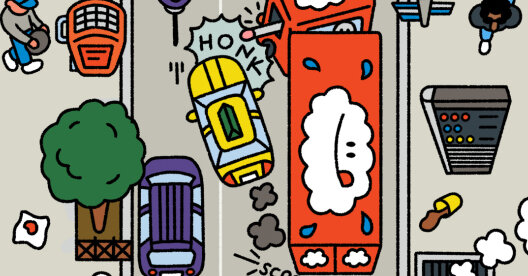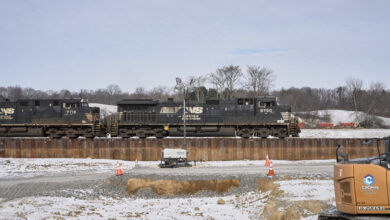NYC Traffic and Parking: Is Congestion Pricing The Answer?

On a recent morning, the intersection of East 77th Street and Lexington Avenue presented a vivid illustration of the tumult.
A taxi trying to make a left turn had to maneuver around a Verizon crew digging up the asphalt. A box truck was parked in the bus lane, and the M102 bus, with its accordionlike belly, was forced to change lanes and snake around it.
Dozens of people streamed out of the subway and into the crosswalk. A man pushing a double stroller navigated between the subway entrance and a sidewalk compost box. A woman’s shopping cart wheels got stuck in a crack in the sidewalk. CitiBikes and delivery bikes whizzed by. A cargo bike stopped in front of a FedEx truck that was unloading packages next to a bike lane.
Lively, energetic streets make city living attractive — people to watch, windows to browse, benches to sit on, trees for shade.
But lately, New York City streets are teetering between lively and unlivable. Residents clash over traffic, noise, parking, 5G towers and heaps of trash. Most years, far fewer pedestrians get killed by motorists than in generations past, but last year was the deadliest year for cyclists since 1999.
Still, people who have thought deeply about the state of the city’s streets believe dramatic improvement may be on the way — if New York is willing to seize the moment.
That’s because the city is about to embark on the nation’s first congestion pricing plan, charging most drivers $15 to enter much of Manhattan below 60th Street — and forcing many commuters to find a different way into the city.
The aim is to reduce car traffic in one of the world’s busiest commercial districts and raise money for public transportation.
People, bikes and vehicles compete for space on New York City’s streets.
Karsten Moran for The New York Times
“I think this could be the catalyst for a streets renaissance in New York,” Janette Sadik-Khan, New York City’s former transportation commissioner, said in a recent interview.
“We have to talk about how we’re going to reclaim that space and make it work for people.”
Of course, congestion pricing, too, comes with a fight. The plan is supposed to start in June, but it faces several lawsuits brought by elected officials and residents from across the region, who describe it as ill-conceived and unfair to commuters who drive because public transit isn’t robust enough to serve their needs.
“They don’t drive because they want to,” said Susan Lee, a member of a coalition called New Yorkers Against Congestion Pricing. “They don’t want to sit in traffic.”
Could congestion pricing actually reduce the number of cars in the city to a dramatic extent? If so, what would take their place?
There are other ideas and experiments in the works for taming New York’s streets, and they raise questions of their own. Could a proposal to ban parking close to intersections improve public safety? Will the Sanitation Department’s garbage containerization plan make sidewalks cleaner? Is there a way to keep package delivery trucks from blocking the streets? Must 5G technology create public eyesores in residential neighborhoods?
In the months ahead, The New York Times will examine the debates raging in neighborhoods all over the city about who and what gets to take up space on New York’s streets and sidewalks.
How did we get here?
Orchestrating the flow of traffic and pedestrians has been a complicated and emotional project for centuries.
New York City’s streets were laid out before anyone knew how they would ultimately be used — long before cars were even invented. The first city planners could not have anticipated Uber vehicles, let alone Amazon deliveries or commuters on electric scooters.
In New York’s earliest days, the streets were a free-for-all. People walked or rode horses. There were no crosswalks or stoplights; if you had to cross the street, you simply walked across the street.
Traffic on Broadway in 1859 consisted of pedestrians, horse-drawn carts, and streetcars.
William Notman, via Getty Images
Soon, horse-drawn vehicles used the streets alongside pedestrians, and people dashed between them. (Later, New Yorkers dodged streetcars in much the same way, giving the Brooklyn baseball team its name.)
The arrival of bicycles neatly encapsulated the city’s ever-shifting debate over how the streets should be used — and by whom.
By the 1890s, the streets were full of bikes. Men and women took to cycling through the city so quickly — and dangerously — that it was called “scorching.”
About 100 years later, in 1987, speeding bike messengers were deemed so dangerous that bicycles were banned from Midtown — temporarily.
Today, the city encourages residents and visitors to ride bikes. New York has bike lanes and a flourishing bike share program, plus an explosion of food delivery powered by e-bikes. The renewed popularity has also come at a grave cost: Last year 30 cyclists were killed on city streets, and 395 were severely injured.
“It’s hard to say whether it’s the best of times or the worst of times for bicycling,” said Jon Orcutt, the director of advocacy at Bike New York and the former policy director at the city’s Department of Transportation. “More people are doing it than ever.”
“If you’re not killed — squished like a bug — you can bike across town in 10 minutes,” he added. “It’s easy. It’s really efficient.”
Enter the car — and the car crash
On the evening of Sept. 13, 1899, Henry Hale Bliss, a 69-year-old real estate broker, was riding a Manhattan streetcar on his commute home.
At 74th Street and Central Park West, Mr. Bliss stepped from the streetcar and into the street, where he was immediately hit by a taxi. He died on the scene and is recognized as the first person in the United States to be killed by a car. There is a plaque at the intersection commemorating his death.
“At the end of the Gilded Age, right before World War I, suddenly, there were motor vehicles everywhere,” said James Nevius, an author and New York historian.
The development meant people could move around faster — but it also put more people in danger.
In 1920, there were about 200,000 registered vehicles in New York City; by 1925 that number had more than doubled. A century later, that figure is two million.
This scene of Park Avenue near 57th Street was typical of 1930s traffic. Over ten million cars went through the Holland tunnel in 1930.
George Rinhart/Corbis, via Getty Images
And yet New Yorkers are still using the same streets that were laid out generations ago. In Manhattan, the rigid street grid was designed in 1811. Avenues are 100 feet across. Cross streets are 60 feet wide, including the space for sidewalks on both sides.
That’s 720 inches in which to fit not just cars but also pedestrians, baby strollers, trash, compost, scaffolding, bicycles, e-bikes, scooters, skateboards, package delivery trolleys, garbage trucks, delivery trucks, food carts, 5G towers, dining sheds, trees, CitiBike docks, buses, taxis, ambulances and on-street parking.
It’s like a giant game of Tetris — except all the pieces just won’t fit.
In fact, some of the pieces are growing larger: In the past decade, the average vehicle got 12 percent longer and 17 percent wider. (Cars’ blind spots have also gotten larger.)
And the number of pieces just keeps expanding. New York City’s population reached 8.8 million in 2020, and the New York region is now home to nearly 19 million people. The city’s population has dropped some in the past few years, but city officials believe that recent population estimates have significantly underestimated the number of newly arrived migrants, which, by some counts, is over 180,000.
Taming the streets
Even as New York’s streets and sidewalks have become more chaotic, there are also plenty of examples of the opposite: moments when the city has tamed the traffic and found new uses for its old spaces.
Over the past 10 to 15 years, sweeping pedestrian plaza initiatives — detouring cars and encouraging space for sitting and strolling — have gradually changed the landscape, from the Jackson Heights neighborhood in Queens to Times Square.
Times Square was once full of traffic. In May 2009, the city closed Broadway to cars and set out lawn chairs, the start of the area’s transformation to pedestrian plaza.
Damon Winter/The New York Times
The Open Streets program restored pedestrian-first streets, free of cars and safe enough for strolling, chatting and letting kids ride bikes.
The coronavirus pandemic ushered in a chance to rethink public spaces, and the absolute quiet on the streets during lockdown was a reminder that the city isn’t inherently noisy, but traffic is.
And there are plenty of other places to look for inspiration: In Bogotá, Stockholm, London and Paris, certain streets are being closed to cars. There is an effort in Europe to avoid the oversize pickup trucks and SUVs that make American roads so deadly. Paris has designated “school streets” where cars have been removed to make way for children. Cycling is flourishing in Europe; emissions are down.
In New York, Ms. Sadik-Khan, the former transportation commissioner, is among the people thinking deeply about the future of streets — and she is optimistic.
“There’s a new generation of New Yorkers who’ve never known a city without protected bike lanes and bike share,” Ms. Sadik-Khan said. “More people than ever are working from home. Commuting patterns are in flux. There’s the opportunity to make a new deal for people getting around.”
What will a “new deal” look like? And will New Yorkers be on board?
No matter what happens, change doesn’t come without a fight — and many of the battles will be fought street by street and block by block.
Over the next few months, we will take a close look at some of these street fights — and we’re eager to hear about yours, too.
Use this form to tell us what you think about the state of New York City’s streets.



